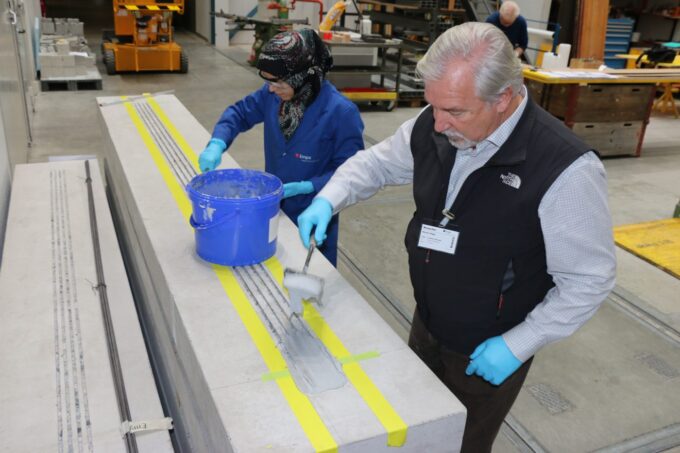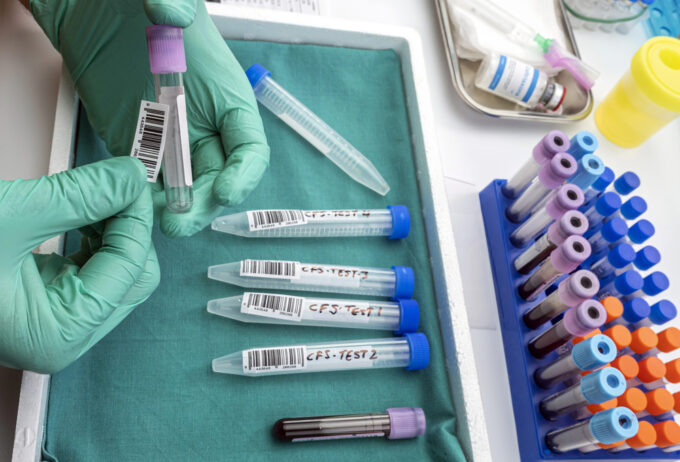Concrete construction: prestressed paving for old buildings
The technology of stabilizing concrete structures with carbon-fiber-reinforced plastic, thus helping them to last longer, was developed decades ago; among others, at Empa. Today, researchers in Dübendorf are working on a new variant with prestressed lamellae - with good prospects for practical application.

Bent concrete beams, cracks on the undersides of bridges, risk of rust for the reinforcement: In Switzerland, many structures are getting on in years. Take national roads, for example: According to the 2019 condition report of the Federal Roads Office (FEDRO), a large proportion of bridges were built from the mid-1960s to the 1980s - with significantly lower traffic loads than today.
Carbon fiber-reinforced plastics (CFRP) have long been used to rehabilitate supporting structures that are groaning under their loads: flat lamellae, bonded to the underside, counteract the load. In the "Ebrog" method (for "externally bonded reinforcement on grooves"), for example, which has only emerged in recent years, narrow grooves are milled longitudinally into the girder in advance for this purpose: more surface area for force transmission, which also acts deeper into the concrete. This method was used for the first time in 2018 for a bridge rehabilitation project in Küssnacht.

Now Empa researchers are developing the method further in an Innosuisse project with industry partner S&P Clever Reinforcement Company in Seewen. The team led by Christoph Czaderski from the "Engineering Structures" research department is testing prestressed CFRP laminates that "actively" reinforce concrete beams: they are bonded with epoxy resin under tensile stress. Once the bond has hardened, the ends are relaxed - and the strips, which "want" to contract, counteract the deflection even more.
Tricky in detail
What sounds simple at first is tricky in detail - especially at the ends of the strips, where enormous tensile forces of up to 14 tons act. To prevent them from tearing off, they have to be reliably fixed. Until now, this has been done with aluminum plates, glued and secured with dowels - but the Empa team has designed U-shaped stirrups made of CFRP specifically for the new method. The advantages: more precisely defined transmission of forces and, above all, a metal-free construction - immune to ubiquitous and dreaded corrosion.

"A solution made of a single material is always better than one made of two that behave differently," explains Czaderski, "especially for the anchoring, we did a lot of tests in the lab." The team benefited from experience at the Isfahan University of Technology in Iran. "A lot of basic research was done there," Czaderski explains. "Our postdoctoral fellow Niloufar Moshiri came to us with the idea of combining the Ebrog process with prestressing."
The potential is great, as tests in the laboratory show: The method with prestressing and CFRP stirrups increased the load-bearing capacity of a concrete slab by 77 percent compared with the "classic" reinforcement method without grooves and prestressing. Even without prestressing, the figure was still 34 percent.

Idea of an expert from Iran
To make the technology ready for the market, large-scale tests on concrete slabs with a span of six meters are to provide further findings before a real renovation project follows in 2021. Meanwhile, the industry partner is already working on practical aspects. The experts are developing an industrial process for the U-bolts, which were previously formed by hand from carbon profiles. And the equipment with which the lamellas have been prestressed up to now "has to be redesigned for the new process," explains Martin Hüppi, who heads the project at S&P and has been cooperating successfully with the Empa experts for a long time.
Efforts that could be worthwhile: Any structure that is rehabilitated rather than rebuilt saves not only costs but also CO2 emissions. In addition, the process would be easier and faster to handle during installation. "It would also be reasonably priced for building owners," says Hüppi, who sees good opportunities for applications - not only in aged large structures such as bridges, but also in residential renovations. "I absolutely see a market for it," says Hüppi, "and with prestressing, you're really exploiting the potential of the material."
Source: Empa









